Welcome to Real-Life Renos, where we're pulling back the curtains to the home renos we just can't get enough of. Tag along as our favorite designers, chefs, and cookbook authors welcome us inside their spaces and share the behind-the-scenes stories behind their transformations. We'll explore their takes on sustainable living, how they express their identities through design, how they create beautiful spaces that center around accessibility — and so much more.
* * *
We bought a home in the midst of the lockdown. I'm not sure how we did it — we are still pinching ourselves — but it was probably a combination of the right timing and a bit of luck, with a lot of patience thrown in (these things in Italy can take months, even without a pandemic).
The apartment is in the historic center of the hilltop town of San Miniato, where my husband Marco was born — and a 40-minute drive from Florence, where I've lived for the past 16 years. We first saw the apartment last March, two days before we were all caught by surprise by what became a three-month lockdown, during which my daughters (who were eight and two) and I didn't get past our front gate. During those long days, I spent a lot of time thinking about the apartment we saw, looking at the photographs I'd taken, and trying to imagine ourselves holed up in an apartment with no outdoor space, and in a new town.
The day the lockdown ended—the very first opportunity we got to travel farther than 200 yards from the front door — we went to do two things: visit my mother-in-law, who had been alone for three months, and view the apartment again. I wanted to see it with new, post-lockdown eyes.
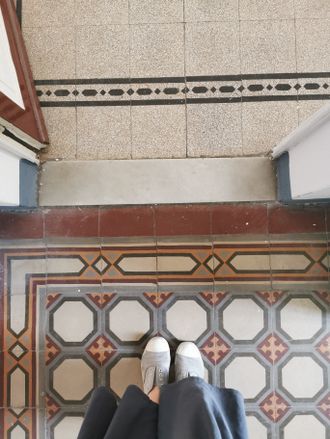
The apartment's original patterned tiles. Photo by Emiko Davies.
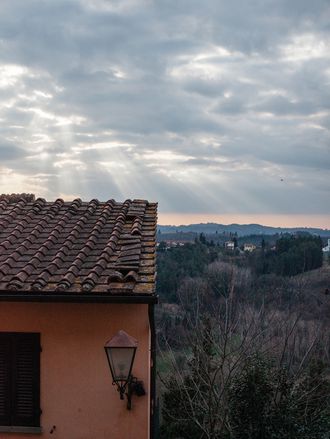
View from the kitchen window. Photo by Emiko Davies.
It didn't take very long for us to know that it was the one. Built in 1800, it came with old patterned tiles, high ceilings with frescoes and wooden beams, seven-foot-tall windows that let the light stream in, and a sunset view over the surrounding valley that had even my two-year-old mesmerized. For me, being able to see the changing seasons from those tall windows, and having a horizon to look at, made up for the lack of outdoor space. It felt good.
The apartment had another thing going for it: It was only a block or two from my favorite butcher in Tuscany, a little organic produce shop, a good pasticceria, a handful of great restaurants, and long-fermented sourdough pizza by the slice. Even one of those things would have been good, but having all of them nearby felt like we'd hit the jackpot! At the back of my mind, I kept thinking that if we ever went into another lockdown, where we couldn't walk farther than 200 yards from home, at least we'd be eating well.
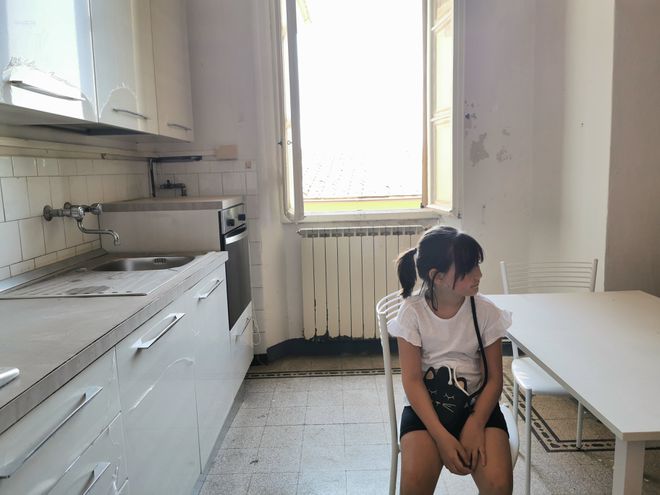
The writer's daughter, Mariù, on an early visit to the apartment. Photo by Emiko Davies.
The first thing I did when our offer was accepted was plan the kitchen. After years of living in shoebox-sized apartments in Florence, I finally had room for the kitchen of my dreams: not enormous, but roomy enough to have space to spread out when cooking, a dining table for the day when friends will be able to join us again (and for now where the girls can play, eat, or do their homework while I'm cooking), and light streaming in through the windows.
The main thing I hoped for was a kitchen that was practical, reliable, and sustainable. The pandemic had rattled us with so much uncertainty: from empty supermarket shelves to job losses, canceled trips, and separation from family. Knowing that we were putting our money toward something that would last — and not have to be replaced for years — was in many ways a cure for a lot of that uncertainty.
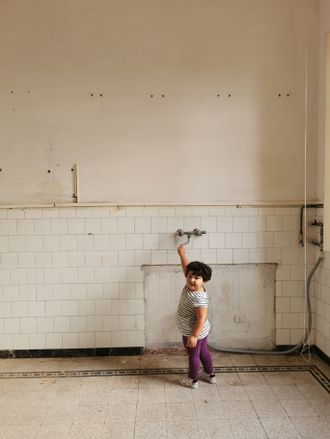
Little Luna calling attention to where the cooktop would go. Photo by Emiko Davies.
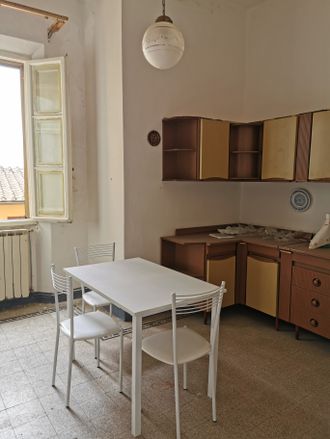
The other side of the kitchen, pre-breakdown. Photo by Emiko Davies.
These were the priorities that led me to look at Very Simple Kitchen, a young, local kitchen design company in Bologna, about an hour and a half away from us. The lockdown-related loss of income for so many Italians made me want to spend my money close to home and support local businesses. Their kitchens are made of versatile modules inspired by vintage industrial workbenches — strong, sturdy stainless steel benches that are powder-coated in any color you can dream up, lending them personality and warmth. We chose a hue that I suppose you could describe as teal, although, depending on the light, it can look like a dark, smoky blue or a deep, warm green. It's the perfect chameleon of a color for an indecisive person, but I also love that it recalls some of the colors in the original tiles in other rooms. The drawers hide a dishwasher (my first ever, so it feels like quite the luxury, but really, with the amount of washing up we do, it's a more energy-efficient solution!), garbage bins, a deep drawer for heavy pots, and a double drawer for cutlery, where there is also a clever hidden drawer for our huge collection of kitchen knives (I love that they are hidden away from the kids yet still handy).
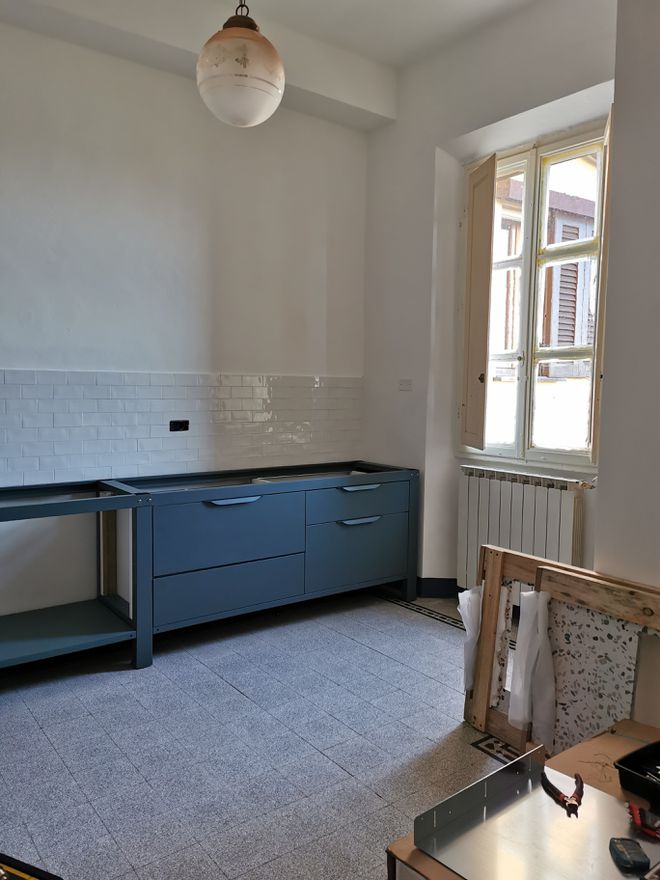
Industrial-style work benches, courtesy Very Simple Kitchen. Photo by Emiko Davies.
I had already fallen in love with the idea of stone terrazzo — an ancient Italian technique where stone and marble offcuts are recycled into a new surface — as a sustainable material for the countertop. It is practical, too: easy to clean, and pretty stain-resistant! My previous kitchen counter was wood, and I vowed never to use it again: It was simply too much work to (make my family) keep it clean. For color, we went with green and rosy peach splatters for a modern yet cheerful palette.
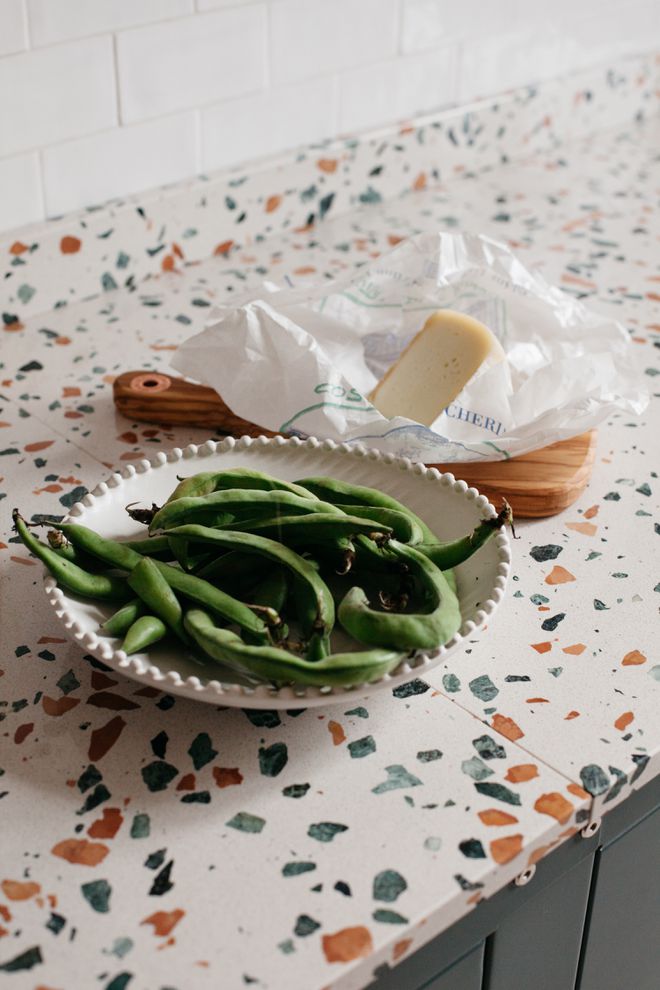
Photo by Emiko Davies.
I hardly ever cook by myself, so we made sure we had a large, long section of counter by placing the stovetop on one end and moving the sink to the other, by the window. When Marco is around, we are often cooking side by side — he might be making bread, I might be recipe-testing or preparing a meal — and the competition for counter space is serious. And when he's not around, I've often got a little kitchen assistant or two either wanting some attention or to be part of the action.
I also knew that we needed a larger, 35-inch cooktop, as Marco and I are constantly fighting for space to cook. We thought long and hard about the kind of cooking surface we wanted. I grew up with a gas cooktop and have never had anything else, but as much as I love cooking on a visible flame, I wanted a cooktop that wouldn't be obsolete five or 10 years from now. We also wanted to be less reliant on nonrenewable energy, which, I'll admit, we still use for our heating (something I'd like to change soon). After doing a lot of research on sustainable options, we chose another neighboring Italian company, Smeg, for our induction stovetop with multiple zones (for maximum flexibility). The change to induction did mean that I had to replace some pans that aren't compatible, like copper and aluminum, but I consider it a positive upgrade.
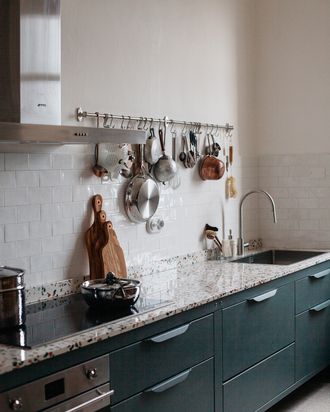
Upper cabinets were sacrificed so the kitchen felt airy and open. Photo by Emiko Davies.
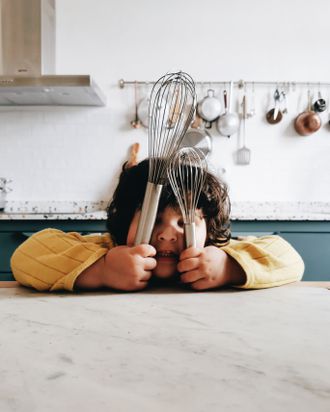
Always a little helper, or two, at the ready. Photo by Emiko Davies.
Without traditional shelves or cupboards above the counter, a big question was where we'd put our things. I had wanted to keep the kitchen looking airy and open, especially with those beautiful tall ceilings, but we were also running over budget. Eventually, we settled on rods that we could hang utensils, boards, and pans off of, to have them at arm's reach. We are converting a small room off the side of the kitchen into a pantry and laundry room, where we will install shelving for all the dry goods, while plates and glasses are in a cupboard on the other side of the kitchen table.

Plates and glasses tucked away in a cupboard on the other side of the kitchen table. Photo by Emiko Davies.
We did away with the idea of a kitchen island, even if we did find it very useful in our last kitchen. In my heart I knew I wanted the space instead for a kitchen table, something I haven't had in my many years of living in minuscule Florentine kitchens, and have long yearned for. In many older Italian cities, having a kitchen large enough to fit a dining table is less common, and apartments that do are advertised as having a cucina abitabile, literally an "inhabitable kitchen." I may be romanticizing the idea of a kitchen table a bit, but to me, it would truly be the beating heart of the house.
Then one day, Marco mentioned there was a table in his mother's attic that he thought we should look at. Her attic is larger than our entire apartment, and it likely lay underneath a mountain of books and nearly 40 years' worth of dust. But when I heard it had a marble top, my interest was piqued! It wasn't until we pulled it out, cleaned it up, and sanded it a bit that I realized its full potential.
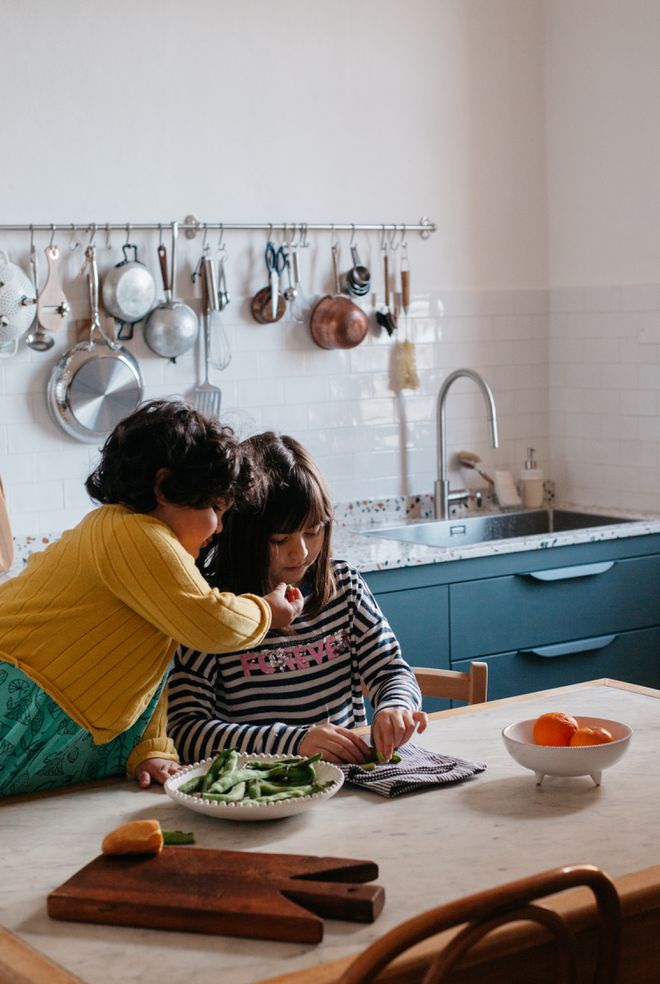
A 100-year-old kitchen table that's a symbol of hope and resilience. Photo by Emiko Davies.
The table had belonged to Marco's great-grandfather Angiolino, who recycled a piece of marble from the old bar he owned that was destroyed during the Second World War and rebuilt in the 1950s; he had a carpenter build a table around the marble slab, and that's where the family ate until Marco was a baby and they upgraded the table. Aside from it being a family heirloom, I liked the idea of using something we already had and giving it a new life (the kitchen chairs, too, were bought from secondhand shops). The idea of watching my little girls grow up around their great-great-grandfather's marble kitchen table feeds the roots we are trying to put down, and fills me with hope that the resilience of this 100-year-old table that has nourished five generations of the family will rub off on anyone who sits down around it.
* * *
Stepping outside the kitchen . . .
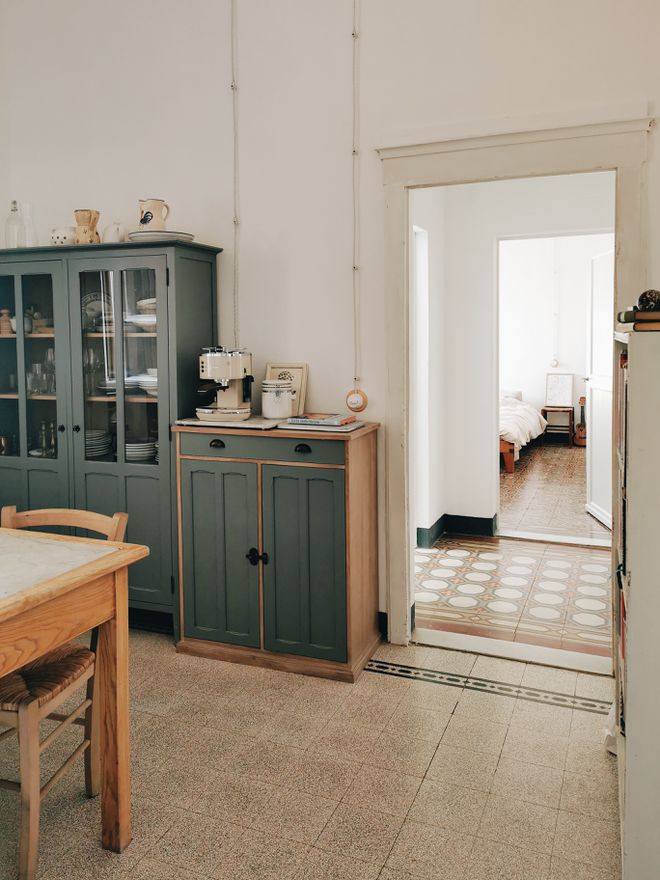
Photo by Emiko Davies.
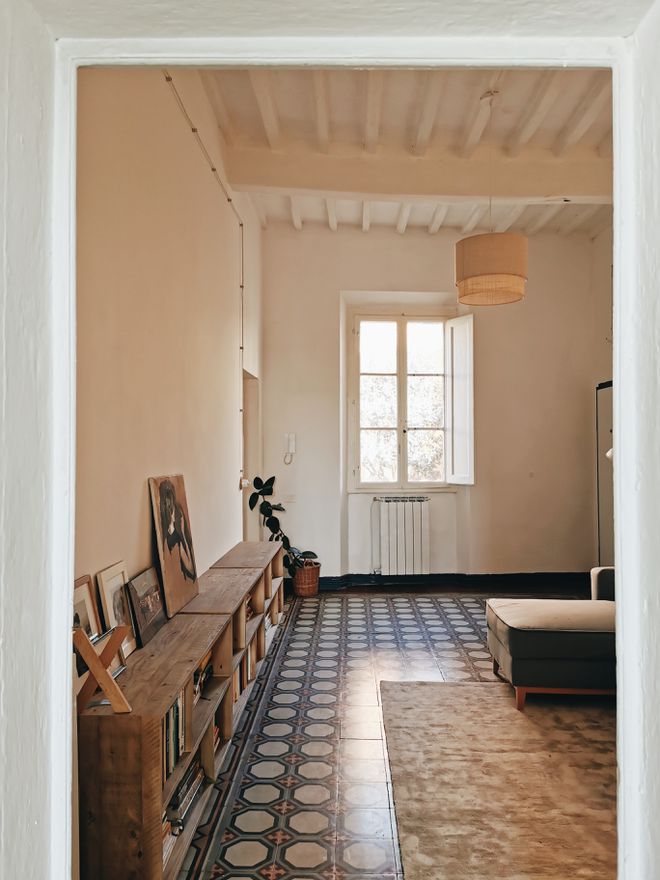
Photo by Emiko Davies.

Photo by Emiko Davies.
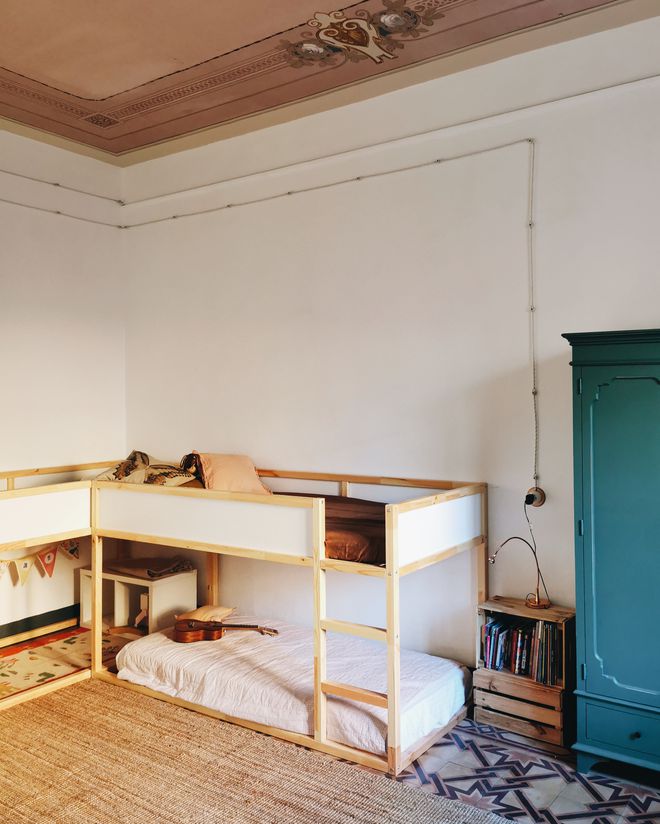
Photo by Emiko Davies.


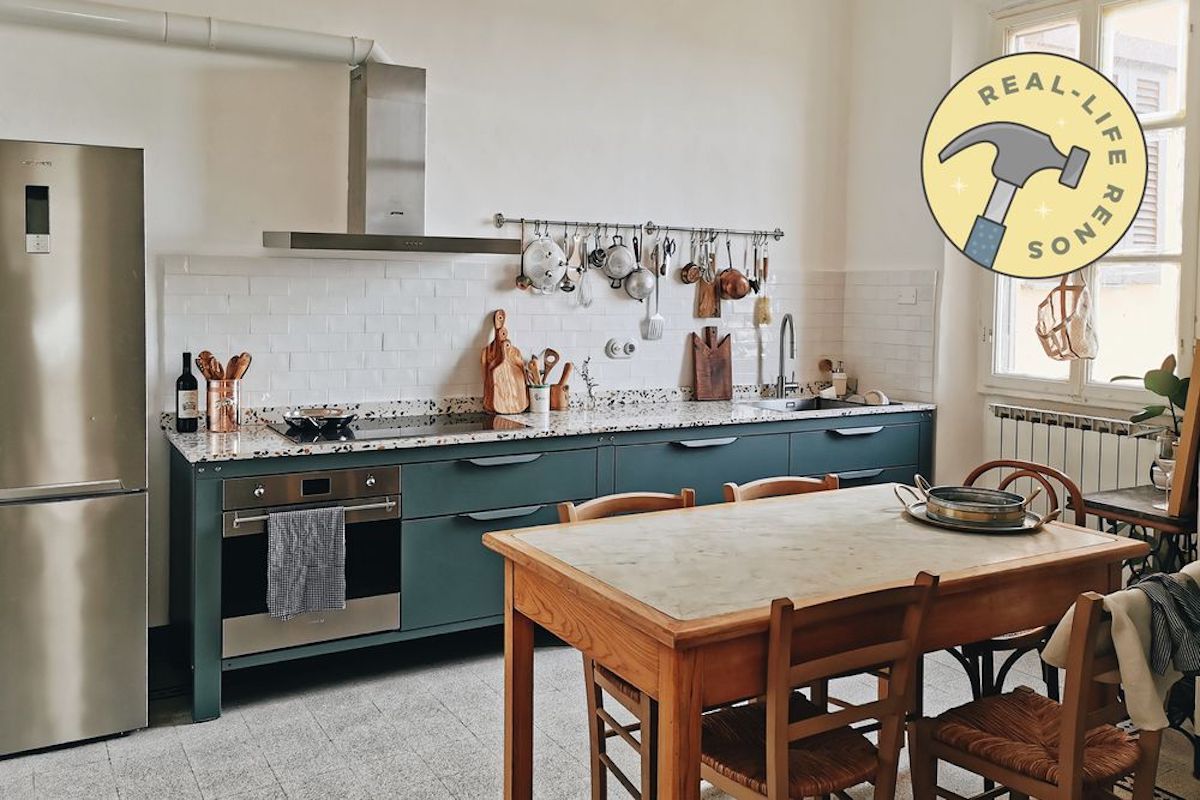

Shares